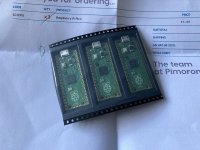The point I was making is that there's nothing new here - it's just packaged/marketed better (and I appreciate the value of that!)
The point of posting the note about this new product and manufacturer entering a crowded market was in the context of pinball related projects only where in my view GPIO's are the key to any successful project. We are firmly embedded here in a parallel 8 bit world because of the chips available back in the 80s hence why we are always burning through so many io ports.... Wireless and Radio features are less important or they are for all the projects i've worked on over the last 5-10 years .
As i was mentioning earlier there is something new (unless i have missed this type of approach on other devices, there are lots after all) that i think helps alot with pinball projects. I didn't get time to read about it much yesterday other than seeing there was some new sort of io assistance.
A quote from it the hackaday article linked previously (
https://hackaday.com/2021/01/20/raspberry-pi-enters-microcontroller-game-with-4-pico/ ) below:
"The real standout peripheral on the RP2040 and the Pico is the Programmable I/O (PIO) hardware, which allows you to define your own digital communication peripheral. There are two of these PIO units, and each one has four programmable state machines that run sequential programs written in a special PIO assembly language. Each of the state machines has its own clock divider, register memory, IRQ flags, DMA interface, and GPIO mapping. These allow essentially arbitrary cycle-accurate I/O, doing the heavy lifting so that the CPU doesn’t have to."
Now, if this appears to be what it sound like and 2 pic16 type devices included internally that you can set up to handle some repetitive function such as polling a switch matrix or updating a lamp matrix then this is big for pinball projects and something i've not seen available before. (I may have missed this on other devices though i guess). The problem so far with any pinball related controller have been the balance to update everything in a timely manner without running into delays even with interrupts. bogging the cpu down moving bits about can be problematic
So , from what i've read so far it does look interesting for pinball projects, of course its a big commitment to move from something you are already happy using isnt it, but its always wise to know what alternatives are around and often with rpi stuff there is scope to get advanced if you want to, its not just for newbies.
And for the cost of things. For real comparisons on devices from china, we should use the ex vat price so these are £3 plus shipping. I got 3 with shipping for just over £10! unbelievable value really.


 Kids really need to grow up knowing more about how technology works.
Kids really need to grow up knowing more about how technology works.